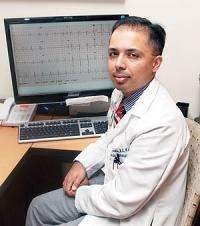Lasting impressions: Turakhia on challenges of treating heart condition in pregnancy

(PhysOrg.com) -- Mintu Turakhia was on call when the woman in the third trimester of pregnancy arrived at Stanford Hospital with increasingly rapid heart palpitations.
Linda Munoz had been rushed to Stanford Hospital & Clinics on a Life Flight helicopter: The 28-year-old pregnant woman was suffering mysterious heart problems, and doctors feared that they could make delivery not only more difficult, but potentially fatal — for both her and her unborn child.
In the late third trimester of her pregnancy, Munoz’s heart had started racing and would not relent. Mintu Turakhia, MD, MS, a cardiac electrophysiologist, was on call for the Stanford Cardiac Arrhythmia Service on that day last year when she arrived. “It was quite scary,” he said. “She was having palpitations that had gotten much worse over the course of her pregnancy. The arrhythmia was becoming more sustained and more rapid.
”The normal changes in the body’s blood circulation during pregnancy made her even more vulnerable to losing blood flow to the brain, which made her light-headed,” added Turakhia, an instructor of medicine. “To complicate things, we also worried that the arrythmia was affecting the circulation of her baby.”
Turakhia diagnosed an irregular heartbeat — right ventricular outflow tract tachycardia — that was interfering with her heart’s ability to pump blood. Working with a range of colleagues at the hospital, he prescribed medications that were safe and suppressed the arrhythmias. Under the care of the Stanford obstetrics team, the patient gave birth to her first child, and mother and baby did well.
While ventricular tachycardia often occurs in patients with heart disease, the form Turakhia identified can occur in otherwise healthy individuals and is sometimes referred to as a “nuisance arrhythmia.” But in periods of stress, like pregnancy, the arrhythmia can become pronounced and potentially life-threatening.
Before her pregnancy, Munoz had felt extra heartbeats and occasional palpitations, but nothing like this. “I was short of breath, light-headed and I could feel my heart racing,” she recalled. “Sometimes I felt like I might lose consciousness.”
Munoz went to see her obstetrician, and he recommended that she be admitted to a community hospital for an electrocardiogram. There, her heart arrythmias were detected, and Munoz was transferred by Life Flight to Stanford.
According to Turakhia, her pregnancy had unmasked her tendency to have this VT. “I was concerned that it was going to damage her heart in the long term,” he said. “To further complicate things, she wanted to have another child, and we couldn’t let her go into another pregnancy without addressing this condition.”
After the birth, Turakhia continued to monitor the young mother condition’s for another four months, when he determined that a cardiac catheter ablation procedure was necessary to help his patient. During that time, even simple tasks, like holding her daughter, caused her to have sustained palpitations.
As a cardiac electrophysiologist who specializes in diagnosing and treating heart rhythm disorders, Turakhia was able to identify the specific site in his patient’s heart where the arrhythmia was occurring. He inserted a catheter in the femoral vein, at the right groin, and then ran it into the heart with the help of fluoroscopy (X-ray) and a sophisticated three-dimensional electronanatomic mapping system. After identifying the cells that were causing the irregular beats, Turakhia zapped them with radiofrequency energy.
“It was a risky procedure because for several months after pregnancy, the tissue of the walls of circulatory vessels become more delicate and can be easily injured,” Turakhia said about the ablation. The procedure heats up tissue in a directed burn of a few millimeters on the surface of the heart and destroys the small number of cells that are firing too fast.
“We had to be very careful, but we were able to find the site, and on the first attempt we terminated the arrhythmia — and cured her,” Turakhia said.
Munoz said she felt better immediately. “There were no more arrhythmias. I couldn’t feel them anymore.”
Paul Wang, MD, director of the cardiac arrhythmia service, noted that although many people have extra heartbeats, fewer than 10 percent of them require an ablation. “But for people who get ablated, it’s terrific,” Wang added. “And this was an excellent case, with an outstanding outcome.”
Turakhia followed his patient closely after the procedure, and had her wear a Holter monitor, a portable device to monitor cardiac events, for three weeks.
“I was very pleased because this made an immediate impact on her life,” he said. “She was able to go back to work, she could hold her child and she could think about having another baby, knowing she won’t be at risk for having these arrhythmias again.”














